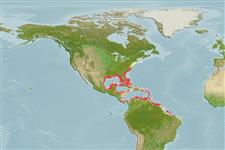Classification / Names
Common names from other countries
Main reference
Size / Weight / Age
Max length : 100.0 cm TL male/unsexed; (Ref. 26938); common length : 60.0 cm TL male/unsexed; (Ref. 55); max. published weight: 22.8 kg (Ref. 40637); max. reported age: 57 years (Ref. 48779)
Length at first maturity
Lm 39.3, range 25 - ? cm
Environment
Marine; reef-associated; depth range 10 - 190 m (Ref. 55), usually 30 - 130 m (Ref. 55)
Climate / Range
Subtropical, preferred 22°C (Ref. 107945); 43°N - 4°S, 100°W - 40°W (Ref. 55228)
Distribution
Western Atlantic: Gulf of Mexico and eastern coast of the USA extending northward to Massachusetts, coasts of Florida (Ref. 26938), but rare north of the Carolinas. Throughout Gulf of Mexico (Ref. 26938). This species has been referred to as Lutjanus aya by previous authors, but Rivas (Ref. 6409) proved that Bodianus aya Bloch, 1790 is not a lutjanid, but probably a sciaenid.
Countries | FAO areas | Ecosystems | Occurrences | Introductions
Short description
Dorsal
spines
(total): 10;
Dorsal
soft rays
(total): 14;
Anal
spines: 3;
Anal
soft rays: 8 - 9. Scale rows on back rising obliquely above lateral line. Specimens under 30 to 35 cm with large dark spot on the upper sides, located below the anterior soft dorsal rays.
IUCN Red List Status (Ref. 115185)
Threat to humans
Reports of ciguatera poisoning (Ref. 30303)
Human uses
Fisheries: commercial; gamefish: yes
Tools
Special reports
Download XML
Internet sources
Estimates of some properties based on models
Phylogenetic diversity index
PD50 = 0.5000 many relatives (e.g. carps) 0.5 - 2.0 few relatives (e.g. lungfishes)
Trophic Level
3.9 ±0.72 se; Based on food items.
Resilience
Low, minimum population doubling time 4.5 - 14 years (K=0.12-0.2; tmax=16; Fec > 1 million)
Vulnerability
High vulnerability (55 of 100)
Price category
